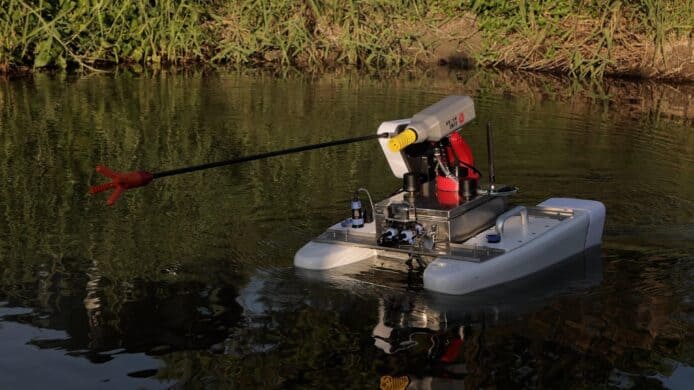In just a little more than three years Aqua Security has set its mark in the container security space. With its major new release of Aqua 3.5, the company has again raised the bar with serverless and container encryption upgrades and feature sets.
I sat down with the Aqua Enforcer himself, Rani Osnat, and “Boston” Andy Feit to discuss the details of this major release. Rani and Andy give us an inside peek.
As usual, the streaming audio is immediately below, followed by the transcript of our conversation.
TranscriptAlan Shimel:Hey everyone, it’s Alan Shimel, DevOps.com, and you’re listening to another DevOps Chat. Today’s chat is a little bit about cybersecurity, container security, Kubernetes and a major new release coming out of our friends at Aqua, Aqua Security. I’m happy to be joined with the dynamic duo of marketing at Aqua, Andy Feit and Rani Osnat. Andy, Rani, welcome.
Rani Osnat:Hi Alan, thank you.
Andy Feit:Hi Alan, good to talk to you.
Shimel:And just so people know, Andy, you’re joining us from Boston today. And Rani, you’re out in Israel. Is that correct?
Feit:Yes. Yes. Today I am in _____ _____ [Crosstalk].Osnat:Right.
Shimel:Modern technology. We have a worldwide panel. But guys, the big news is, Aqua just announced version 3.5 of their platform suite of tools. And you know, Aqua’s not a company that every single new time there’s a new release, and the DevOps mantra, you can’t get too excited about any one release. Right? Because there’s always a next one and a next one and a next one. But this is one to get excited about, huh?
Feit:Absolutely.
Osnat:We certainly think so.
Shimel:So why should we be excited?
Feit:Rani, you want to take that one?
Osnat:Yeah, I’ll take this one. So, with every release we make, especially, and in the beginning of course everything’s new. But we’ve been in this space now for three years. Which is not a long time, but in this space it’s a very long time. And so now we’re at the point where we have a lot of large enterprise customers using our product. And we have a market that’s looking for innovation.
And with every new release we try to balance these factors of, you know, offering something new that the market wants. But at the same time ensuring that our enterprise customers can make use of our platform, as they themselves grow their cloud native container implementations. So there is a maturity factor here as well as an innovation factor.
And so on the innovation side, we’re introducing a few significant innovations. First and foremost, risk assessments for serverless functions. Which is a, you know, a kind of a sideways expansion for us into the serverless technology space, in addition to containers. Thinking that you know, what we see as, it’s basically the same teams and the same benefits that are gotten from containers people expect to get from serverless, it’s just another means to get the same end.
And so we want to provide our customers with all the controls they need to address any challenges they have around securing those technologies. And it doesn’t matter if they use containers or serverless or both, or any sort of mixed environment. We also added something that’s innovative in the space, which is container encryption, and we can talk about that.
And then on the side of enterprise scalability and ease of use, we’ve added quite a significant I would say rearchitecting of how we manage both administrative controls on our platforms and what users can do in terms of access. As well as the policy engine to make it a lot more scalable for multicloud, multiteam, multiapplication use.
Shimel:Got it. Got it. Andy, did Rani leave anything out you want to add?
Feit:No, I mean, those are the big pieces that are in the release. As he said. I mean, it’s very much being driven by our customer base and where they’re headed. And you know, in some aspects, it’s the technology elements. Like adding serverless. And in other aspects, it’s really about living with the solution. You know, as our customers, we now have customers that are we think the largest container deployments in the enterprise.
We have some very large users and span of different industries. As they look to roll out, they’re finding they have multiple teams working on these projects. And they need to implement different levels of security. And in many cases, they’re implementing that on different technology stacks. And some are using containers, some are using serverless environments.
And they may be using even different underlying providers of some of the infrastructure. Whether that’s tools for development or the cloud provider itself. And so we’re really, we’re becoming very heterogeneous in terms of what we need to support. And for our customers who, on the security side, are trying to look at that whole context and manage that whole context and have consistent policies, all our consistent reporting across all of them, and not be monitoring 17 different dashboards. It’s important that it be easy to do, to be able to see that whole network of activity. And that’s really what a lot of this release is about.
Shimel:So guys, one of the things that you mentioned, both of you actually mentioned, was the serverless piece. And this is something that we are, we’re hearing a lot about from our readers and from people we speak to. You know, how quickly, and we live in crazy times, right? So the whole container revolution, if you backed up on hypervisors. And now, how quickly serverless is you know, gaining a foothold and people are building around that type of infrastructure.
Osnat:Right.
Shimel:Let’s, just baseline, what are some of the security challenges that you guys are seeing around this?
Osnat:Right. So I’ll preamble that, you know, just add one more thing. There’s, you know serverless has been around almost as long as containers have, in terms of the, you know, its current incarnation of the use in the cloud. But, the use cases is quite different. And while it is gaining traction, the use cases are much more limited than containers. There’s a whole kind of religious war, you know, between the proponents of containers and the proponents of serverless. Personally I don’t believe it’s a zero sum game. I think that both are going to end up being used, and both are going to end up being used in hybrid architectures.
Shimel:Yeah, I don’t think it’s either or.
Osnat:Yeah, I know, but some people would like you to think it is. I don’t think it is. I think it’s both. And so we, but there are some fundamental differences between containers and serverless when it comes to security. First of all, most of the serverless workloads that happen today are cloud based and specific to a cloud provider, right? Mostly Amazon, because Amazon is the larger cloud provider in general, as well as in serverless specifically with Lambda.
But basically you run those functions and it’s quite cloud specific. That’s one area of difference. The other is of course that you know, these are very small single-function entities that can run for a fraction of a second. So when we talk about run time security for serverless, for example, there is a lot less to do there than you have with containers.
Containers are, there are applications that can run, they could run for a minute but they often run for a lot longer than that. With something that runs for a split of a second, there is really only so much you can do when it’s already running. So a lot of t
















